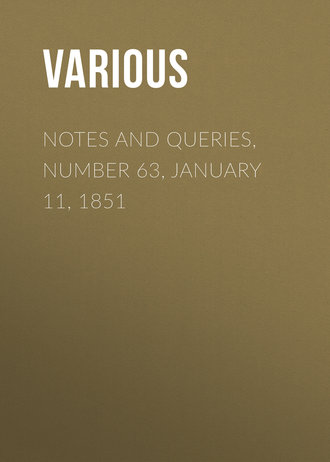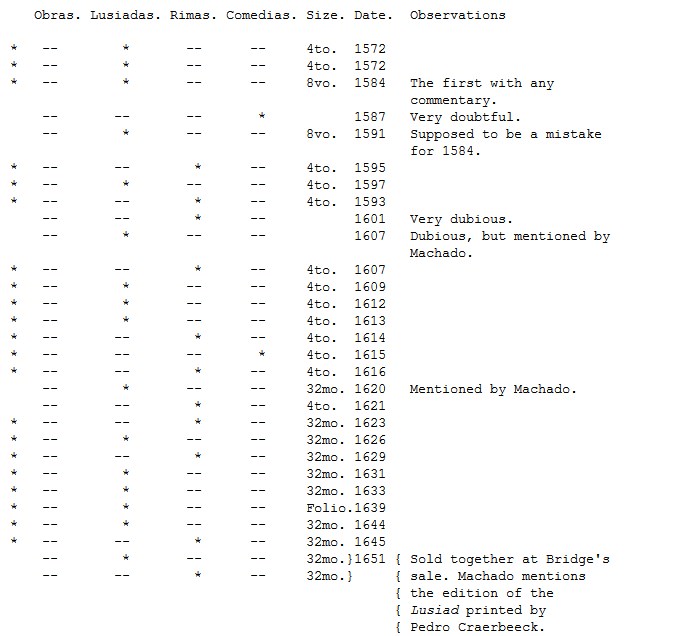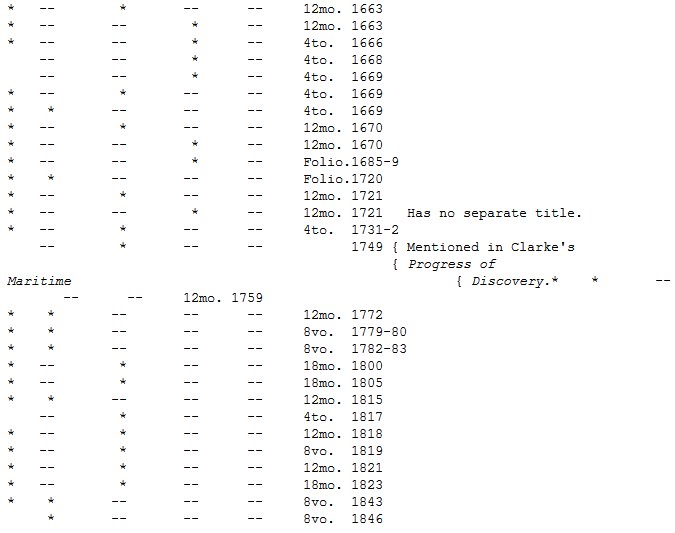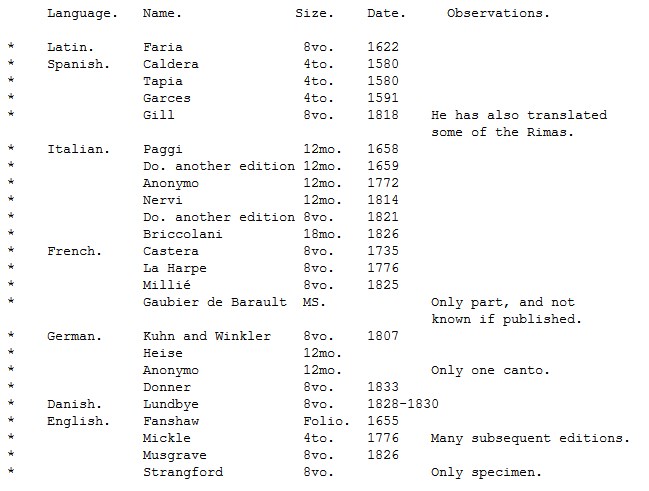 полная версия
полная версияNotes and Queries, Number 63, January 11, 1851

Various
Notes and Queries, Number 63, January 11, 1851
NOTES
THE BREECHES, OR GENEVA BIBLE
Of this, the most popular edition of the Scriptures in the reign of Queen Elizabeth, we meet continually with erroneous opinions of its rarity, and also of its value, which the following brief statement may tend in a degree to correct.
The translation was undertaken by certain reformers who fled to Geneva during the reign of Queen Mary; and is attributed to W. Whittingham, Anthony Gilby, Miles Coverdale, Thomas Sampson, Christopher Goodman, Thomas Cole, John Knox, John Bodleigh, and John Pullain; but Mr. Anderson, in his History of the English Bible, says that the translators were Whittingham, Gilby, and Sampson: and from the facts stated, he is, no doubt, correct.
It is called the "Breeches Bible" from the rendering of Genesis, iii. 7.:
"Then the eyes of them bothe were opened, and they knewe that they were naked, and they sewed fig tree leaves together, and made themselves breeches."
The first edition of the Geneva Bible was printed at Geneva in 1562, folio, preceded by a dedication to Queen Elizabeth, and an address "To our beloved in the lord the brethren of England, Scotland, Ireland," &c.; dated from Geneva, 10th April, 1561. This edition contains two remarkable errors: Matt. v. 9. "Blessed are the place makers." Luke xxi. "Chris condemneth the poor widow." This is the first Bible divided into verses.
Second edit. 4to., printed at Geneva, 1569. To this edition is added "Certeine Tables, A Calendar, and Fairs in Fraunce and elsewhere."
The first edition printed in London is a small folio. Imprinted by Christopher Barker, 1576.
The first edition of the Scriptures printed in Scotland is the Geneva version, folio, began 1576, by Thomas Bassandyne; and finished in 1579 by Alexander Arbuthnot.
Other editions, 1577, London, sm. fol.; 1578, sm. fol.; 4to., 1579; two editions 4to., 1580, 1581; sm. fol.; 1582; 4to., 1583; lar. fol., 1583; 4to., 1585; 4to., 1586; 8vo., 1586; 4to., 1587; 4to., 1588; 4to., 1589; 8vo., Cambridge, 1591, supposed to be first printed at the university; fol., 1592; 4to., 1594; 4to., 1595; fol., 1595; 4to., 1597; sm. fol., 1597; 4to., 1598; 4to., 1599. Of this last date, said to be "Imprinted at London by the deputies of Chr. Barker," but probably printed at Dort, and other places in Holland, there were at least seven editions; and, before 1611, there were at least twenty other editions.
Between the years 1562 and 1611, there were printed at least 130 editions of the Geneva Bible, in folio, 4to., and 8vo.; each edition probably consisted of 1000 copies.
Persons who know but little of the numbers which are extant of this volume, have asked 100l., 30l., and other like sums, for a copy; whereas, as many shillings is about the value of the later editions.
The notes by the Reformers from the margin of the Geneva version, have been reprinted with what is usually called King James' version, the one now in use, in the editions printed at Amsterdam, at the beginning of the seventeenth century.

POEMS DISCOVERED AMONG THE PAPERS OF SIR KENELM DIGBY
MR. HALLIWELL (Vol. ii., p. 238.) says that he does not believe my MS. of the "Minde of the Lady Venetia Digby" can be an autograph. I have reason to think that he is right from discovering another MS. written in the same hand as the above, and containing two poems without date or signature, neither of which (I believe) are Ben Jonson's. I enclose the shorter of the two, and should feel obliged if any of your correspondents could tell me the author of it, as this would throw some light upon the writer of the two MSS.
THE HOURGLASSEDoe but consider this small dust running in this glasse, By atoms moved;Would you believe that this the body ever was Of one that loved;Who in his mistresse flames playing like a fly, Burnt to cinders by her eye?Yes! and in death as life unblest, To have it exprestEven ashes of lovers have no rest.I also enclose a copy of another poem I have discovered, which appears to me very curious, and, from the date, written the very year of the visit of Prince Charles and Buckingham to the court of Spain. Has it ever been printed, and who is the author?
What sodaine change hath dark't of late The glory of the Arcadian state?The fleecy flocks refuse to feedeThe Lambes to play, the Ewes to breede The altars make(s) the offeringes burne That Jack and Tom may safe returne.The Springe neglectes his course to keepe, The Ayre continual stormes do weepe,The pretty Birdes disdaine to singe,The Maides to smile, the woods to springe, The Mountaines droppe, the valleys morne Till Jack and Tom do safe returne.What may that be that mov'd this woe? Whose want afflicts Arcadia so?The hope of Greece, the proppe of artes,Was prinly Jack, the joy of hartes. And Tom was to his Royall Paw His trusty swayne, his chiefest maw.The loftye Toppes of Menalus Did shake with winde from Hesperus,Whose sweete delicious Ayre did flyThrough all the Boundes of Arcady, Which mov'd a vaine in Jack and Tom To see the coast the winde came from.This winde was love, which Princes state To Pages turn, but who can hateWhere equall fortune love procures,Or equall love success assures? So virtuous Jack shall bring from Greece The Beautyous prize, the Golden fleece.Love is a world of many paines, Where coldest hills, and hottest playnes,With barren rockes and fertill fieldesBy turne despaire and comforte yeldes; But who can doubt of prosperous lucke Where Love and fortune both conducte?Thy Grandsire great, and father too, Were thine examples thus to doe,Whose brave attempts, in heate of love,Both France and Denmark did approve. For Jack and Tom do nothing newe When Love and Fortune they pursue.Kind shepheardes that have lov'd them long, Be not rasfe in censuringe wronge,Correct your feares, leave of to mourne,The Heavens will favour their returne; Committ your cares to Royall Pan, For Jack his sonne and Tom his man.FINISFrom London, 31. Martii, 1623.
Prefaced to this poem is an extract from a letter of Buckingham's to his wife, containing an account of their reception: but it is hardly worth copying.
H.A.B.WORKS OF CAMOENS
Having been requested by a foreign nobleman to furnish him with a list of the editions of the works of Camoens, and of the various translations, I have prepared one; and considering the information might be interesting to several of your readers, I send you a copy for insertion It besides affords an opportunity of asking after those editions, to which I have added the observations. The first star indicates that the works are in my private collection, as are several other works relating to that celebrated poet. Obras means the collected works.
JOAN ADAMSON.Newcastle-upon-Tyne, Dec. l6. 1850.
EDITIONS OF THE WORKS OF LUIS DE CAMOENS


N.B. There are several translations of portions of the Lusiad, and of the smaller poems, both in French and English.
FOLK LORE
May Cats.—In Wilts, and also in Devon, it is believed that cats born in the month of May will catch no mice nor rats, but will, contrary to the wont of all other cats, bring in snakes and slow-worms. Such cats are called "May cats," and are held in contempt.
H.G.T.Folk Lore of Wales: Shewri-while.—There is a legend connected with one of the Monmouthshire mountains (Mynydd Llanhilleth), that was, until very recently, implicitly believed by most of the residents in that neighbourhood. They stated that the mountain was haunted by a spirit in the form of a woman, and known by the name of "Shewri-while." Her principal employment appears to have been misleading those whose business or inclination led them across the mountain; and so powerful was her influence, that few, even of those who resided in the neighbourhood, could cross the mountain without losing their way. If some unlucky wanderer hesitated in which direction to go, Shewri would attract his attention by a loud "whoo-whoop," and with upraised arm beckon him on. If followed, she glided on before him: sometimes allowing him to approach so near, that the colour and arrangement of her dress could be distinguished; at other times, she would only be seen at a distance, and then she frequently repeated her call of "whoo-whoop." At length, after wandering over the mountain for hours in the hope of overtaking her, she would leave her weary and bewildered pursuer at the very spot from which he had first started.

Charm for the Tooth-ache.—The following doggerel, to be written on a piece of parchment, and worn round the neck next to the skin:
"When Peter sat at Jerusalems gateHis teeth did most sorely eake (ache)Ask counsel of Christ and follow meOf the tooth eake you shall be ever freeNot you a Lone but also all thoseWho carry these few Laines safe under clothesIn the name of the Father Son and Holy Ghoste." (Copied verbatim.)G. TR.Quinces.—In an old family memorandum-book, I find the following curious entry:
"Sept. 15. 1725. My Father Mr. – – brought my mother home to my grandfather's house, and the wedding dinner was kept there on Monday, Sept. 20., with all the family, and Mr. – and Mr. – and his wife were present.
"In the Evening my Honoured Grandfather gave all his Children a serious admonition to live in Love and Charity … and afterwards gave his wife a present of some Quinces, and to his sister –, and every Son and Daughter, Son in Law and Daughter in Law, Five Guineas each."
The last-named gift consisted of gold five-guinea pieces of Charles II. and James II., some of which have been preserved in the family. The part of the record, however, which appears to me worthy of note, is that which concerns the quinces, which brings to one's mind the ancient Greek custom that the bridegroom and bride should eat a quince together, as a part of the wedding ceremonies. (See Potter's Grecian Antiquities.)
Can any of your readers furnish any additional information on this curious point?
H.G.T.ELIZABETH WALKER.—SHAKSPEARE
I have before me a reprint (Blackwell, Sheffield, 1829) of The Holy Life of Mrs. Elizabeth Walker, late Wife of A. Walker, D.D., Rector of Fyfield, in Essex, originally published by her husband in 1690. It is a beautiful record of that sweet, simple, and earnest piety which characterised many of the professors of religion in the seventeenth century. It is not, however, the general character of the book, however excellent, but an incidental allusion in the first section of it, that suggests this communication. The good woman above named, and who was born in London in 1623, says, in her Diary:
"My dear father was John Sadler, a very eminent citizen. He was born at Stratford-upon-Avon, where his ancestors lived. My grandfather had a good estate in and about the town. He was of a free and noble spirit, which somewhat outreached his estate, but was not given to any debauchery that I ever heard of. My father's mother was a very wise, pious, and good woman, and lived and died a good Christian. My father had no brother, but three sisters who were all eminently wise and good women, especially his youngest sister."
It is, I confess, very agreeable to me, amidst the interest of association created by the world-wide fame of the "Swan of Avon," to record this pleasing tribute to the character of the genius loci at so interesting a period. In a passage on a subsequent page, Mrs. Walker, referring to some spiritual troubles, says:
"My father's sister, my dear aunt Quiney, a gracious good woman, taking notice of my dejected spirit, she waylaid me in my coming home from the morning exercise then in our parish."
This was in London: but it is impossible to have read attentively some of the minuter memorials of Shakspeare (e.g. Hunter's, Halliwell's, &c.) without recognising in "Aunt Quiney" a collateral relationship to the immortal bard himself. I am not aware that any Shakspearian reader of the "NOTES AND QUERIES" will feel the slightest interest in this remote branch of a genealogical tree, which seems to have borne "diverse manner of fruits;" but assuredly the better portion of those who most justly admire its exuberance of dramatic yield, will not disparage their taste should they equally relish the evangelical flavour of its "holier products," exemplified in the Life of Mrs. Elizabeth Walker.
J.H.OLD ENGLISH ACTORS AND MUSICIANS IN GERMANY
(Vol. ii., pp. 184. 459.)The following extracts furnish decisive evidence of the custom of our old English actors' and musicians' professional peregrinations on the continent at the beginning of the seventeenth century—a subject which has been ably treated by Mr. Thoms in the Athenæum for 1849, p. 862.
In September, 1603, King James I. despatched the Lord Spenser and Sir William Dethick, Garter King-at-arms, to Stuttgart, for the purpose of investing the Duke of Würtemberg with the ensigns of the Garter, he having been elected into the order in the 39th year of the late Queen's reign. A description of this important ceremony was published at Tubingen in 1605, in a 4to. volume of 270 pages, by Erhardus Cellius, professor of poetry and history at that University, entitled: "Eques auratus Anglo-Wirtembergicus." At page 120. we are told that among the ambassador's retinue were "four excellent musicians, with ten other assistants." (Four excellentes musici, unà cum decem ministris aliis.) These performed at a grand banquet given after the Duke's investiture, and are described at p. 229. as "the royal English music, which the illustrious royal ambassador had brought with him to enhance the magnificence of the embassy and the present ceremony; and who, though few in number, were eminently well skilled in the art. For England produces many excellent musicians, commedians, and tragedians, most skilful in the histrionic art; certain companies of whom quitting their own abodes for a time, are in the habit of visiting foreign countries at particular seasons, exhibiting and representing their art principally at the courts of princes. A few years ago, some English musicians coming over to our Germany with this view, remained for some time at the courts of great princes; their skill both in music and in the histrionic art, having procured them such favour, that they returned home beautifully rewarded, and loaded with gold and silver."
(Musica Anglicana Regiæ, quam Regius illustris Legatus secum ad Legationis et actus huius magnificentiam adduxerat: non ita multos quidem sed excellenter in hac arte versatos. Profert enim multos et præstantes Anglia musicos, comœdos, tragædos, histrionicæ peritissimos, è quibus interdum aliquot consociati sedibus suis ad tempus relictis ad exteras nationes excurrere, artemq'; suam illis præsertim Principum aulis demonstrare, ostentareq'; consueverunt. Paucis ab hinc annis in Germaniam nostram Anglicani musici dictum ob finem expaciati, et in magnorum Principum aulis aliquandiu versati, tantum ex arte musica, histrionicaq'; sibi favorem conciliârunt, ut largiter remunerati domum inde auro et argento onusti sint reversi.)
Dancing succeeded the feast and then (p. 244.) "the English players made their appearance, and represented the sacred history of Susanna, with so much art of histrionic action, and with such dexterity, that they obtained both praise and a most ample reward."
(Histriones Anglicani maturè prodibant, et sacram Susannæ historiam tanta actionis histrionicæ arte, tanta dexteritate representabant, ut et laudem inde et præmium amplissimum reportarent.)
W.B.R.[See, also upon this subject, a most interesting communication from Albert Cohn in the Athenæum of Saturday last, January the 4th.]
MINOR NOTES
The Curse of Scotland.—In Vol. i. p. 61., is a Query why the Nine of Diamonds is called the Curse of Scotland. Reference is made to a print dated Oct. 21, 1745, entitled "Briton's Association against the Pope's Bulls," in which the young Pretender is represented attempting to lead across the Tweed a herd of bulls laden with curses, excommunications, indulgences, &c.: on the ground before them lies the Nine of Diamonds. In p. 90. it is said that the "Curse of Scotland" is a corruption of the "Cross of Scotland," and that the allusion is to St. Andrew's cross, which is supposed to resemble the Nine of Diamonds. This explanation is unsatisfactory. The nine resembles St. Andrew's cross less than the five, in a pack of cards; and, moreover, the nine of any other suit would be equally applicable. The true explanation is evidently to be found in the game of Pope Joan, in which the Nine of Diamonds is the pope. The well-known antipapal spirit of the Scottish people caused the pope to be called the Curse of Scotland.
The game of Pope Joan is stated to have been originally called Pope Julio, and to be as old as the reign of Queen Elizabeth. See Sir John Harington's "Treatise on Playe," written about 1597, Nugæ Antiquæ, vol. i. p. 220.
L.George Herbert.—It is much to be desired that the suggestion thrown out by your correspondent (Vol. ii., p. 460.) may be acted upon. The admirers of George Herbert are doubtless so numerous, that the correct and complete restoration of Bemerton Church might be effected by means of a small subscription among them, as in the case of the Chaucer monument. Most gladly would I aid in the good work.
R.V.[It is needless for us to add that we shall be glad to promote, in every way, the good work proposed by our correspondent.—ED. N. AND Q.]
Dutch Versions of English Essayists.—How much the works of the British Essayists were appreciated by my Dutch ancestors, the following plain facts may show. I have now before me
A translation of the Tatler:
"De Snapper, of de Britsche Tuchtmeester. Door den Ridder Richard Steele. Uit het Engelsch vertaald door P. le Clerc. t'Amsterdam, by Hendrik Vieroot, 1733, iv. vol. in 12º."
A second edition of
"De Guardian of de Britsche Zedemeester, door den Ridder Richard Steele. Uit het Engelsch vertaald dor P. le Clercq. Te Rotterdam, by Jan Daniel Beman, 1734, iii. vol. in 12º."
A third edition of
"De Spectator, of verrezene Socrates. Uit het Engelsch vertaald door A.G. & R.G. (some volumes by P. le Clercq) t'Amsterdam, by Dirk Sligtenhorst, Boekverkooper, 1743, ix. vol. 12º."
JANUS DOUSA.Long Meg of Westminster (Vol. ii., p. 131.).—The same epithet has been applied to women in other places. In the parish Register of Tiverton, Devon, is the following entry:
"Burials. April, 1596. The long


Why should "long Meg" be more fabulous than "long Jone?"
E.A.D.Errors in the Date of Printed Books.—In the title-page of Peter Heylin's Microcosmos, 8th ed., the date is printed 1939 instead of 1639. In like manner, in Historical Applications and occasional Meditations upon several Subjects, written by a Person of Honour, printed in 1670, the imprimatur, signed "Sam. Parker," is dated 1970, instead of 1670. In each of these cases the error is evidently caused by the compositor having inverted the figure 6, which thus became 9.
P.H.F.QUERIES
DOUSA'S POEM ON SIDNEY.—OLD DUTCH SONG-BOOK
Your correspondent, who subscribes himself JANUS DOUSA in the last number of "NOTES AND QUERIES," ought to be able, and I dare say will be able, to supply through your columns information of which I have been long in search. In 1586 his great namesake printed at Lugd. Batav. a collection of Greek and Latin poems upon dead and living persons of distinction. Geoffrey Whitney, an Englishman, apparently residing at Leyden, and who printed two works there in his own language, has fifteen six-line stanzas preceding Dousa's collection, and he subjoins to it a translation of a copy of Dousa's verses on the Earl of Leicester. Of these I have a memorandum, and they are not what I want; but what I am at a loss for is a copy of verses by Dousa, in the same volume, upon Sir Philip Sidney. It is many years since I saw the book, and I am not sure if there be not two copies of verses to Sidney, in which he is addressed as Princeps; and if your correspondent can furnish me with either, or both, I shall be much obliged to him.
Will you allow me to put another question relating to an old Dutch song-book that has lately fallen in my way; and though I can hardly expect a man like JANUS DOUSA to know anything about such a trifle, it is on some accounts a matter of importance to me, in connection with two early English songs, and one or other of your many friends may not object to aid me. The book is called De zingende Lootsman of de Vrolyke Boer, and it professes to be the tweede druk: the imprint is Te Amsteldam By S. en W. Koene, Boekdrukkers, Boek en Papierverkoopers, op de Linde Gragt. The information I request is the date of the work, for I can find none; and whether any first part of it is known in England, and where?
You are probably aware that the Dutch adopted not a few of our early tunes, and they translated also some of our early songs. These I am anxious to trace.
THE HERMIT OF HOLYPORT.MINOR QUERIES
Sir Cloudesley Shovel.—In Mrs. Markham's History of England it is stated that Sir Cloudesley Shovel escaped from the wreck of his ship, but was murdered afterwards by a woman, who on her death-bed confessed it.
Is there any authentic record elsewhere published?
H.J.Christopher Flecamore.—Walton says that Sir H. Wotton wrote his well-known definition of an ambassador at Augusta (Augsburg), in the Album of "Christopher Flecamore." (Wordsworth, Eccl. Biog., vol. iv. p. 86., ed. 1839.) Can any of your correspondents tell me who this person was?
J.C.R."Earth has no Rage," &c.—Can you, or any of your contributors or readers, inform one where the following couplet is to be found:
"Earth has no rage like love to hatred turn'd,And hell no fury like a woman scorn'd."I do not trouble you idly, as I have a particular reason for desiring to know the source of the lines.
W.T.M.O. and C. Club
D'Oyly and Barry Families.—Any authentic information, original or not in the usual depositories, concerning the two great Norman races of D'OYLY and BARRY, or De Barry (both of which settled in England at the Conquest, and, singularly, both connected themselves with mistresses of King Henry I.), will be thankfully received if sent to WM. D'OYLY BAYLEY (Barry), F.S.A., whose histories of both races are still unfinished.
Coatham, near Redcar, Yorkshire.
Lord Crewe, Bishop of Durham.—A collector of scraps and anecdotes relating to Nathaniel Lord Crewe, Bishop of Durham, would be glad to know whether, in the various MS. collections of our public libraries, there are extant any letters either written by that prelate or addressed to him?
E.H.A.Epigram on the Synod of Dort.—In the Biographie Universelle, art. GROTIUS, it is stated that the following singular distich against the Synod of Dort was made in England:—











